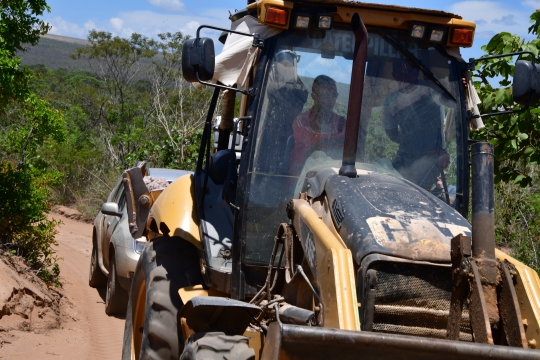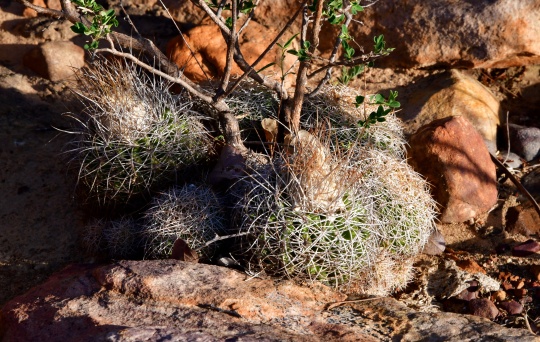Tuesday, 20 November 2018 – Rio de Contas to Morro do Chapeu
From memory, our first stop of the day was just north of Piatã,(S3694) to play in a huge sandpit (quarry, doubling up as a waste disposal site) to look for Marlon’s Micranthocereus hofackerianus. The plant was originally described by Pierre Braun as Arrojadoa multiflora subsp. hofackerianus. Marlon noticed that the plants had a lateral cephalium rather than the ring cephalium found in Arrojadoa. (\ (http://forum.bcss.org.uk/viewtopic.php?t=75226).
As I was searching for the plants between the tall grasses and low shrubs I heard shouts from the track that ran parallel to the one I had selected. As I walked over, I saw the Dusters stuck in the soft sand. Marlon had already walked back to where we had seen workmen and equipment that might resolve our problem. They had pulled out the Dusters in no time at all!
The heat was now my main issue. It was 37 C when we reached the stop near Seabra (S3695) where we were going to climb to the cross at the top of the hill to see Mircanthocereus streckeri, the one with a nice Mohican punk rocker cephalium. Alain and I said ‘no thanks’ and just strolled around the base of the hill. Marlon then shouted that he had found a nice spot where both M. purpureus, M. streckeri and a hybrid grew together, about 1/3 up the hill. I had already made it to the top in 2009 – how many medals do you need? One more!
I made my way back to the car and on the way found a very nice fence of Pereskia stems and in full flower!
During our previous two visits to northeastern Brazil, Morro do Chapéu had become a firm favourite of mine. We stopped some 20 km west of town (S3696) along BA-052, at the same stop that we visited several times in 1999 and 2009. Originally, we christened this ‘the boomianus site’, because of the presence of a dense population of Discocactus zehntneri subsp. boomianus.
Since then, it has also been referred to as ‘Succulentum Maximus’ as I’ve photographed 17 different taxa of cacti and other succulent plants here. I’ll have to compare this to a spot along MEX1 in Baja California Norte where we found a similar number. On this occasion, the sun had passed its ‘best by’ moment for photography so we did not stay as long as on past occasions, but for the record, here are the taxa recorded from here over the past twenty years:
- Arrojadoa rhodantha
- Cereus albicaulis
- Cereus jamacaru
- Discocactus zehntneri subsp, boomianus
- Dyckia sp.
- Euphorbia phosphorea
- Euphorbia sarcodes
- Leocereus bahiensis
- Melocactus albicephalus (= M. erythracanthus x M. glaucescens)
- Melocactus concinnus
- Melocactus ernestii f. erythracanthus
- Melocactus glaucescens
- Micranthocereus flaviflorus subsp. densiflorus
- Pereskia bahiensis
- Pilosocereus gounellei subsp. zehntneri
- Pilosocereus pachycladus
- Tacinga inamoena
In addition, another 20 taxa can be found around the town:
- Arrojadoa penicillata
- Discocactus bahiensis subsp. gracilis
- Harrisia adsendens
- Melocactus ferreophilus
- M. pachyacanthus + subsp. viridis
- M. paucispinus
- M. zehntneri ‘douradoensis’
- Micranthocereus polyanthus subsp. alvinii
- M. purpureus
- Pilosocereus caatingicola
- P. glaucochrous
- P. pachycladus
- P. pentaedrophorus
- P. tuberculatus
- Pseudoacanthocereus brasiliensis
- Stephanocereus leucostele
- S. leutzelburgii
- Tacinga funalis,
- T. palmadora and T. werneri
It is no surprise that many of these plants are now protected. The Parque Estadual do Morro do Chapéu (Morro do Chapéu State Park) covers an area of 46,000 hectares and was established in
1973, but no action was taken to implement the park.
A team from the State University of Feira de Santana concluded a study for a new polygon to define the area of the park. As of 2011 problems had been caused by opening a road inside the park, hunting, deforestation, logging and complete lack of surveillance, particularly in the west of the park. Landowners had still not been compensated. In addition to the cacti, there is a wealth of orchids and bromeliads and big cats (cougars) that also benefit from the protection offered in the park.
In 2009 we stayed in the comfortable ecohotel Pousada Ecologica das Bromelias and hoped to stay there again this time but they had increased their prices greatly. We had seen much more basic accommodation along the BA-052 so that, once again, we enjoyed a room each.
Marlon contacted Father Delmar and invited him to join us at the excellent Italian restaurant in town. Delmar is a senior citizen who for many years had run an orphanage in town. He has a keen interest in nature with orchids in particular. In 1999, we first met him with a group of students staying in the same hotel. We were given a frosty welcome over breakfast. Marlon asked him if we had upset him or his students. ‘I don’t like Americans’ he said. Wrong! We are British and Dutch. ‘You’ve come to steal our Orchids!’ Wrong! We’ve come to ‘steal’ your cacti, but only their pictures, we support conversation! He began to warm to us and told his students to be nice to us.



